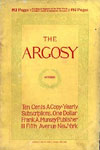Wonder Stories
In June 1929, Hugo Gernsback released his second SF-centric periodical, Science Wonder Stories, after having sold Amazing Stories (1926-) earlier that year on account of bankruptcy. Wonder Stories ("Science" was dropped from the title a year after its debut) was every bit the successor to Amazing: its "bedsheet" format featured both new authors and perennial favorites such as Jules Verne and H.G. Wells; artist Frank R. Paul continued to provide stunning cover illustrations; and there were numerous "real world" features, such as "Science Questions and Answers" and "Science News of the Month," influenced by Gernsback's personal conviction that science fiction had a place in "making the world a better place," through an understanding, and extrapolation, of current scientific knowledge.
Despite competition from other SF magazines, most notably Astounding Stories (beginning in 1931), and various augmentations to the title's price and physical dimensions over the years, Wonder Stories enjoyed relative success throughout the early 1930s. Circulation dived well below 50,000 by 1936, however, and Gernsback sought to save his periodical by "eliminating the middle man," as it were, and going straight to his readers, offering a subscription-only title. This strategy ultimately failed, resulting in the selling of Wonder Stories to Ned Pines of Standard Publishing, a firm best remembered today for the Nedor catalog of super-heroes featuring The Fighting Yank and The Black Terror.
Following the sale, the title of the magazine was changed to Thrilling Wonder Stories. Edited by Mort Weisinger (later to helm the Superman titles at DC Comics), the new Wonder emphasized action and adventure, in a decidedly-more "pulpish" manner than Gernsback's brainchild which had trumpeted "Prophetic Fiction and Scientific Fact." Thrilling Wonder Stories (through several succeeding editors) survived the 1930s and 1940s. Unfortunately, despite luring some of Astounding's stable of writers—such as Leigh Brackett, A.E. van Vogt, and Arthur C. Clarke—to its pages, Wonder became yet another causality of the mass extinction of pulp magazines in the post-war years. It finally ceased publication in the winter of 1955.
Wonder Stories, regardless of incarnation or publisher, is now remembered for two significant accomplishments: the discovery of new talent and the fostering (some may even say creation) of science fiction fandom. In addition to presenting early science fiction's proven talents, such as Raymond Z. Gallum and John Scott Campbell, Wonder Stories provided a pathway to professional publication for numerous "new-comers", such as Raymond A. Palmer (1930), Clifford A. Simak (1931) and Ray Bradbury (1943, first "solo" story).
As with Amazing Stories, Gernsback encouraged communication between his readers in the form of letter columns, competitions, writing contests, clubs, and even the spreading of SF awareness during "Science Fiction Week." Through Wonder Stories, Gernsback created one of the first SF communities, the Science Fiction League, which historian Mike Ashley believes "did more for science fiction fandom than anything before or since."
Nathan Vernon Madison, Virginia Commonwealth University
Works Consulted
Michael Ashley, ed. The History of the Science Fiction Magazine – Vol. 1, 1926-1935. Chicago: Henry Regnery Company, 1976.
Marshall B. Tymn and Mike Ashley, ed. Science Fiction, Fantasy and Weird Fiction Magazines. Westport, CT: Greenwood Press, 1985.
Harry Warner, Jr. All Our Yesterdays – An Informal History of Science Fiction Fandom in the Forties. Chicago: Advent Publishers, Inc., 1969.





